Cotonou
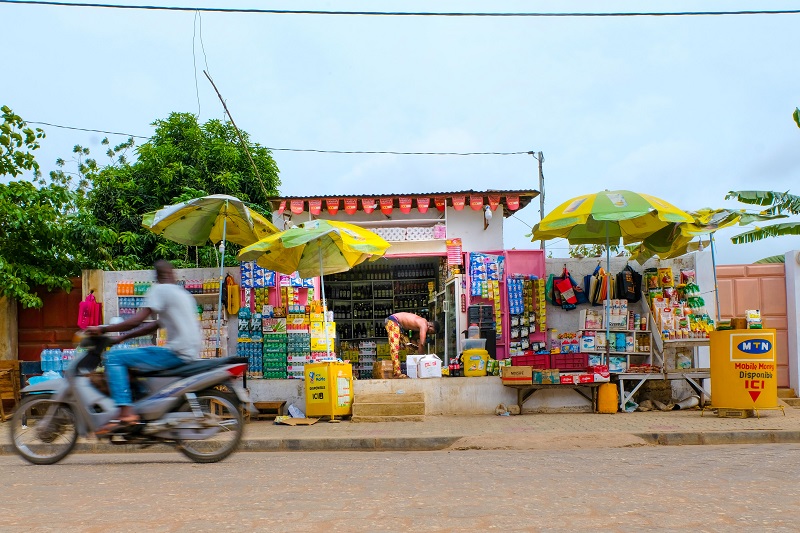
A store at Wakadje, Cotonou, Benin Republic
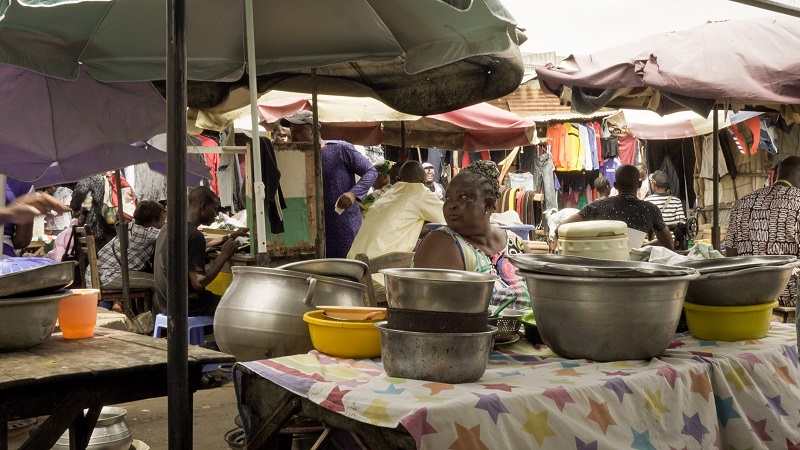
A Togolese woman sells Togolese food at Missebo market, Benin Republic
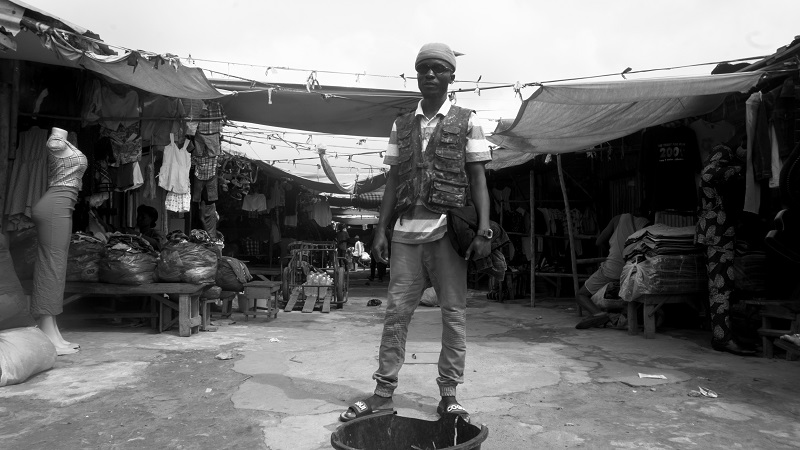
A Nigerian migrant that sells cloth at Missebo Market, Benin Republic
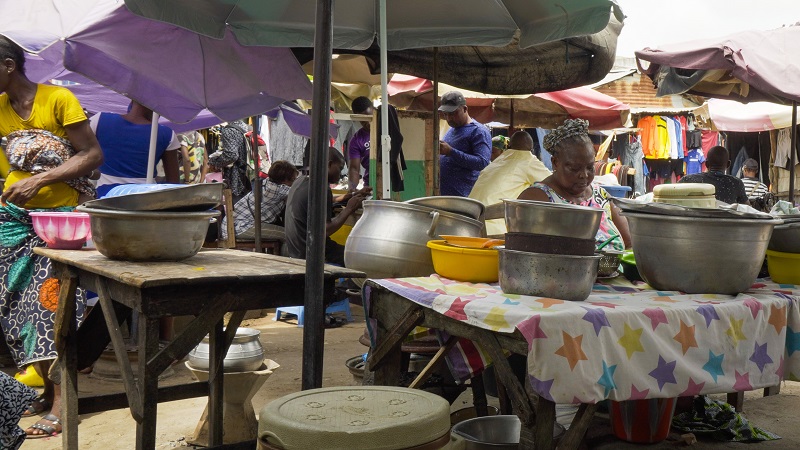
Food stall of a Togolese migrant at Missebo, Benin Republic

Beverages imported to Cotonou from Nigeria
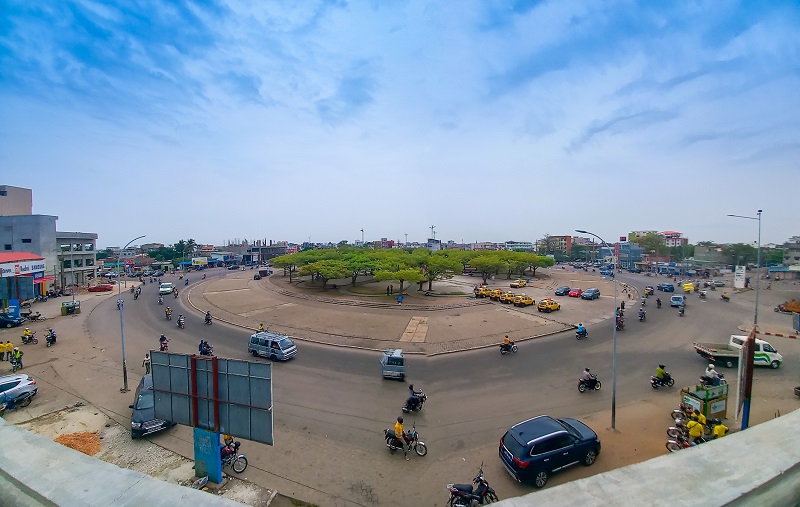
Etoile Rouge, Cotonou, Benin Republic
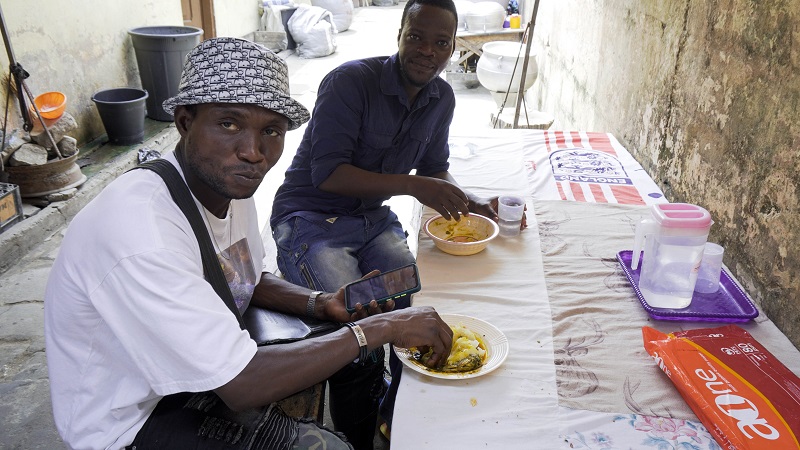
A Togolese merchant, eating at Missebo market, Benin Republic
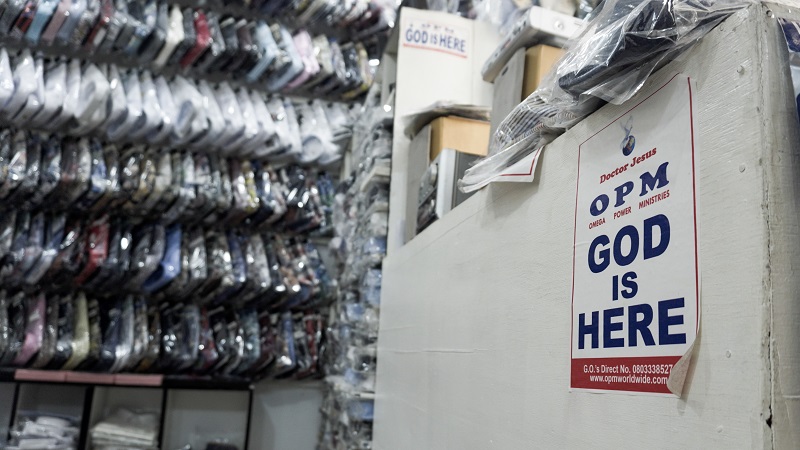
A cloth store with the sticker of a Nigerian church
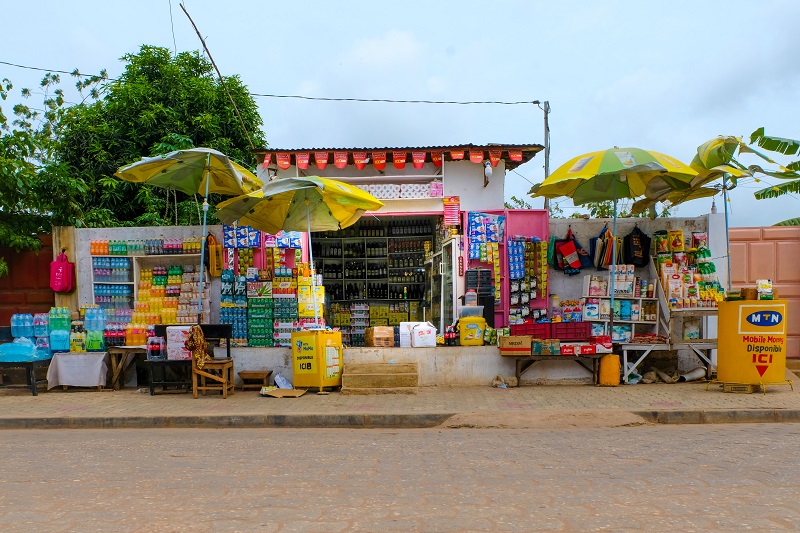
This store contains mostly goods brought into Cotonou from Nigeria
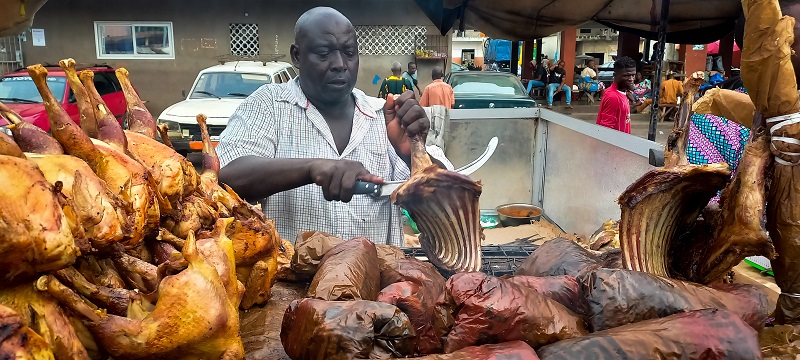
Nigerian Migrant from Sokoto at Jonquet Benin Republic
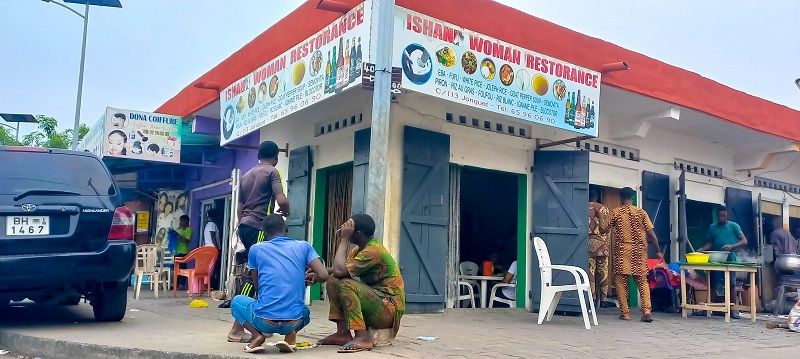
Jonquest, a major Nigerian enclave at Benin Republic
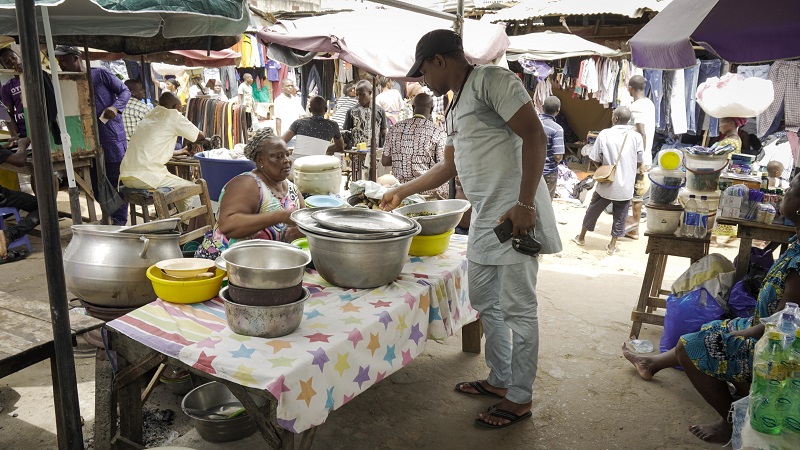
One of the researchers at the stall of a Togolese food seller at Missebo market, Benin Republic
Cotonou City Profile
Introduction
Cotonou is the economic capital and the largest city of Benin Republic with 1,228,667 inhabitants in 2021 according to PopulaionData.net. It is also home to many government and diplomatic services. Located on the Gulf of Guinea, the city of Cotonou stretches between the Atlantic coast and Lake Nokoué. The city has an area of 79 km², was originally created on the initiative of King Ghézo of Abomey in 1830 for needs related mainly to the slave trade for which Kutonu, now Cotonou, served as a transit point and ‘boarding. An important transit city in the West African region and a major business hub crossroads on the continent, Cotonou owes its economic and commercial openness to the performance of its Port and its Airport (recognized as the lungs of Benin). Cotonou has a particular administrative status and is erected into a department (Department of Littoral). The city of Cotonou is subdivided into 13 districts, and the districts into districts. Cotonou is known throughout West Africa for its 20-hectare international market (Dantokpa) considered the largest market in West Africa, its Zémidjans (motorcycle taxis) and a secondary market Missebo, located a few meters from the Dantokpa market.
In recent years, the poorest population, that of the countryside, has been rushing to the cities and has significantly inflated the size of the big cities, and in particular that of the metropolises of the coast. Some cities that were once large towns lost in the bush now have several hundred thousand inhabitants, for whom basic equipment does not exist. Water, sewage, roads, education, health services etc. are failing and often even non-existent. The leaders are overwhelmed by the phenomenon of urbanization, which is becoming widespread in Africa.
The most disadvantaged populations come to look for work in the city, work which they do not always find. The slums surrounding the country’s largest city, Cotonou, are swelling exponentially. Cotonou is now a large urban area of more than 2.4 million inhabitants, and its population which is growing at a frantic rate (+4.8%/year) leads to problems of pollution, insecurity, distribution and water treatment etc.
However, the country benefited somewhat from the political and economic crisis in Côte d’Ivoire during the first decade of 2000. Indeed, the port of Cotonou greatly increased its activity at the expense of that of Abidjan, which contributed to the creation of many jobs in the region. But besides this port, economic activity remains dependent on cotton exports, which represent 75% of the country’s income. This monoculture is hampering the development of the country, which is struggling to compete with developed countries such as the United States of America and Europe, which are largely subsidized in this area.
The urban area of Cotonou has institutional cultural spaces, but it is the independent initiatives that are the most active. Thus, the arts biennial launched in 2009 on the initiative of artists and associations is developing with alternative venues. The artist Dominique Zinkpè, father of Sikamè Zinkpè, is one of the most active in the country and has carried out artistic actions and performances with an ecological and social dimension, such as the proposal to stop the circulation of motorcycle taxis for a few minutes to a peak hour, causing a reduction in pollution. The National Ballet of Benin, or artistic and cultural association of Benin (EACB), is based in Cotonou, where it provides cultural activities. The Hall of Arts, Leisure and Sports (HALS) is a space where shows are played and which regularly hosts events of all kinds. (https://www.goafricaonline.com/bj/14650-hall-arts-loi sirs-sports-centre-cotonou-benin).
Migrants from Nigeria can be classified into three major ethnics groups: Yoruba, Igbo and Hausa. They are mostly into trading such as selling of food (Nigerian foods), Money exchange, Second hand clothes, and boutiques, sales of electronic gadgets, electrical appliances, tailoring &co. Nigerians migrants and the other West African migrants live in areas like Dantokpa, Missebo etc.
Below are the characterisctics of immigrants and foreigners
Countries of origin | Majority of immigrants are from West African countries: Niger (34.8%), Togo (22.1%), Nigeria (20.5%) and Burkina Faso (4.6%). |
Settlements | Cotonou (36.8%), Alibori (19.1%), Borgou region (11.8%). In the case of Cotonou, foreigners are estimated to represent as much as 7.8% of the city’s population. (INSAE, 2013) |
Socio-demographic profile | Males represent around 60% of foreign nationals. In the case of Togolese nationals, female migrants are almost twice as numerous as males. (INSAE, 2013) |
Socio-economic profile and sectors of employment | – Migrants generally have little formal education: 19.5% have primary education and 16.4% have secondary or higher education. (INSAE, 2013) – Most foreigners are employed within the trade and catering sector (54.1%) and in agriculture (22.6%).(INSAE, 2013)
|
Migration trends and migrant characteristics
Migration as we all know is the act of moving to live from one place, city, country or continent to another one. In order to have a better understanding we need to look at the following:
- Key factor driving migration and general cross-border mobility
- Immigration and/ or Emigration
- Irregular migration (primary focus of the study)
- History of migrants to the city and specific geographic enclaves (Lagos-Cotonou)
Key factor driving migration and general cross-border
Many factors are driving migration and general cross-border mobility in Benin republic like in other countries. Benin republic as a country presents a number of attractive factors which are key in driving migration into the country. And the key factors are the political stability of the country since 1990, its maritime coast and its location in the prosperity zone of West Africa.
Immigration
The activities of the tertiary sector and those of the primary sector are the motivating factors of migrant workers from West Africa. Figure 9 shows the level of attraction of West African immigrants linked to factors in the formal or informal economy of the departments of Benin. There is a high concentration of West African immigrants in the Littoral. Cotonou being the economic metropolis of Benin, this city constitutes a source of attraction for immigrants from all origins and wishing to work in Benin in the formal tertiary sector or not. It should also be noted that large cohorts of West African immigrants have settled in the departments of Mono, Atlantique, Ouémé, Collines, Donga, Borgou and ‘Alibori. These cohorts are between 6765 and 14160 immigrants. And very few of them have settled in the departments of Couffo, Zou, Plateau and Atacora. These are the cohorts of 14,160 to 19,839 immigrants. These are departments that are experiencing internal displacement of populations to other departments such as Collines and Borgou.
Irregular migration
Irregular migration as its name refers is the type of immigration that is practiced illegally. That is to say, it is the act of immigrating illegally or immigrating without fulfilling the required conditions. Within the framework of ECOWAS we realised that any citizen of ECOWAS wishing to migrate within the ECOWAS countries must provide an International or an ECOWAS passport that he will present either at the land border or at the airport before boarding. But nowadays, the passport is mostly used at the airport. And for those who are travelling by road are not really using their passport to cross the border. Because having the passport does not guarantee the easy crossing of the border. Most of them need to pay (N500- N1, 000) for their passport to be stamped. Some show virtually no identification card. They only need to pay N500-N1, 000 to cross the border. The most common practice at the borders of Nigeria and Benin is the crossing of the border by motorcycles. These motorcycles operate at the borders used to help prospective migrants to cross in exchange for a sum of N1, 000-N1, 500. After crossing borders, no formality or documentation is required. And the latter integrate socio-economic life.
History of migrants to the city
The history of the number of immigrants shows that Benin had 34,019 immigrants in 1960. This stock was only doubled in 1990 when Benin rose to 76,212 immigrants. In 1995, this stock of immigrants in Benin reached 104,971 while in 2010, this number was 209,267 immigrants. Between 1990 and 2015, the migratory stock increased from 76,212 to 245,399 immigrants, or approximately 322% in 25 years. The average annual flow during the period from 1960 to 2015 and especially the observation of the series from 1995 to 2015 better reveals the gradual increase in the trend of immigration to Benin. One could rightly say that Benin has certainly remained a country of emigration, but more and more is its tendency to also be a country of immigration is strengthening. We observe that the average annual increase is 3,843 migrants from 1960 to 2015. But from one series to another the variation is very significant and coincides with important milestones of the implicit or explicit policy. Thus, the average annual flow between 1960 and 1975 was 1,090 immigrants, that from 1975 to 1990 was 1,721 immigrants, while the average annual migratory flow was 5,752 per year between 1995 and 2000. These average annual flows increased during the decade. 2000 and remained constant from 2000 to 2005 and from 2005 to 2010. They revolve around 7,554 immigrants. For the series from 1990 to 2015, the average annual flows are 6,767 immigrants in Benin. The increasingly important flows of immigrants in Benin coincide with the period of stabilization of the institutions of Democratic Renewal emanating from the National Conference of February 1990. Political stability, respect for human rights, freedom of enterprise, liberalism economy and regained confidence, appear as factors of attraction of immigrants in Benin. In this context, immigrants have developed a positive view of the destination of Benin. The major challenge here is the preservation of these factors of political stability sensed by candidates for migration (Banégas, 2004).
Key migration linkages
Who are the people moving from Nigeria to Benin republic and what are they moving?
Trans-border movement is not a single process or a once-and-for- all activity, but a ‘form’ of migration in its own right, with distinct features. Movements across a border may comprise normal everyday movement and conventional migration – which could be regarded as being both internal and international. Some aspects of the uniqueness of this form of migration are its spontaneity, the complexity of its pattern and the categories of the movers. Its spontaneity is evident from its almost impulsive and repetitious manner of occurrence. The complexity of its pattern stems from the fact that the same socio-cultural group is found on both sides of the border (Afolayan, 2004). Nigerians move from their country to Benin Republic considering the similarities of culture. They equally move for business opportunity and the quest for a better life according to the feedback we got from some Nigerians we interviewed in Cotonou, Benin republic. Some said they left Nigeria due to the fact that they don’t believe in our leaders. While some said they saw some business opportunity in Cotonou that will help them achieve their dream.
The sharp depreciation of the naira since1986 and the growing attractiveness of the franc CFA for Nigerian traders are major factors that help to explain the regional dynamics of the two countries and the high level of official and undocumented trade between them. Foodstuffs such as foreign rice, frozen chicken/turkey and tinned foods, beverages, soaps are the main items of trade among traders both at the Benin republic border and in the city of Cotonou.
Migrant enjoyment of right, education, employment, housing and citizenship
Migrants in Benin and most especially in Cotonou have not complained of bad treatment from either the public authorities or the Beninese. All the migrants interviewed said they are all enjoying their rights. They said not to have experienced any form of discrimination. They are their family members have right to education, housing. As per the employment they can be employed in the informal sector and private, but cannot be employed in the public sector except if they have the Beninese citizenship. The Beninese citizenship can only be gotten after following due process for application.
Impact of migration
Impact of migration on migrant
People most time migrate in the quest for a better life. Which imply that they leave their homes to a more comfortable zone. As a consequence, many migrants experience a large increase in income when they move to richer economies e.g. a Nigerian or Beninese migrating from Nigeria or Benin republic to France or United Kingdom has the currency advantage over his counterpart in Nigeria or Benin due to the exchange rate and a good pay in his favour. The gains from migration are larger the younger the migrant is because younger migrants have a longer lifetime ahead of them to benefit from the extra income; hence the present discounted gains from migration are higher (IMF, 2020 WEO). Other factors in favor are the level of education and other skills acquired that are high in the destinations countries. The aforementioned factors play a vital role in the profile of people who migrate.
Impact of migration on destination country
International migration has oh advantage and disavantages. It is both a challenge and an opportunity for destination countries. On the one hand, especially in the short run, immigrants can create challenges in local labor markets, potentially affecting wages and displacing some native workers who compete with them. Their arrival may also impose a short-term fiscal cost. On the other hand, especially in the medium and long run, immigrants can boost output, create new opportunities for local firms and native workers, supply abilities and skills needed for growth, generate new ideas, stimulate international trade and contribute to long-term fiscal balance, by making the age distribution of advanced countries more balanced.
Impact of migration on origin countries
Remittances are perhaps the most highly visible and tangible benefit of emigration to the origin countries. On a global level, the World Bank estimates officially recorded remittances at $548 billion in 2019, more than three times the volume of official development assistance and comparable in size to total FDI flows. Not surprisingly, remittances have become a major source of inflows in many countries. They are often in the range of 15-20 percent of GDP, and in some exceptional cases, can reach 30-40 percent of GDP (Tonga, Haiti, Kyrgyz Republic).
Migration governance
Policy framework- national migration policy and priorities
The Treaty establishing ECOWAS was signed in Lagos on 28 May 1975. Article 27 states the long-term objective of establishing a Community citizenship, which should be granted automatically to all Member States’ nationals. Seven years later, the Supplementary Protocol A/SP3/5/82 set out the definition of a Community Citizen. The Treaty was revised on 24 July 1993 in order to pursue the following goals: a) promote cooperation and integration between Member States to establish an economic union in West Africa, b) maintain and enhance economic stability, c) foster relations among Member States, and d) contribute to the development of the African continent.
As stated in Article 3 of the revised Treaty, the Community considers the “removal between Member States, of obstacles to the free movement of persons, goods, services and capital, and to the right of residence and establishment” one of its major goals. Article 59 of the revised Treaty establishes ECOWAS citizenship and affirms the right of citizens of the Community to entry, residence, and establishment: “Citizens of the community shall have the right of entry, residence and establishment and Member States undertake to recognise these rights of Community citizens in their territories in accordance with the provisions of the Protocols relating thereto”.
1979 ECOWAS Protocol relating to the Free Movement of Persons, the Right of Residence and Establishment and supplementary protocols
Four years after the establishment of the Community in 1979, the ECOWAS Member States signed the Protocol on Free Movement of Persons, the Right of Residence and Establishment in Dakar to enable free movement of ECOWAS citizens61 within the region. The protocol stipulates the right of Community citizens to enter, reside, and establish businesses in Member States, to be granted over a transitional period of 15 years through three phases. Phase I eliminated the need for visas for stays of up to 90 days in ECOWAS Member States by Community citizens. Phase II regulated Community citizens’ right of residence on Community territory for the purpose of seeking and taking up paid employment. Phase III aims at facilitating the establishment of businesses through the right of Community citizens to carry out economic activities in other ECOWAS Member States. The protocol was further complemented by four supplementary protocols with a view to operationalising the three phases. Phase I came into force in 1980 with the ratification of the 1979 Protocol by all Member States, while Phase II came into force in 1986. Phase III has not yet been implemented.
The four supplementary protocols are the following:
i the Supplementary Protocol A/SP.1/7/85 on the Code of Conduct for the implementation of the Protocol on Free Movement, Right of Residence and Establishment;
ii the Supplementary Protocol A/SP.1/7/86 on the second phase (Right of Residence) of the Protocol on Free Movement, Right of Residence and Establishment;
iii. the Supplementary Protocol A/SP.1/6/89 amending and complementing the provisions of Article 7 of the Protocol on Free Movement, Right of Residence and Establishment; and
- the Supplementary Protocol A/SP.2/5/90 on the implementation of the Third Phase (Right of Establishment) of the Protocol on Free Movement, Right of Residence and Establishment.
In addition, in 1985, the ‘Decision A/DEC.2/7/85 on the Establishment of a Travel Certificate for ECOWAS Member States’ was adopted. Furthermore, in 1990, the ‘Decision C/DEC.3/12/92 on the Introduction of a Harmonized Immigration and Emigration Form in ECOWAS Member States’ was adopted, which sets the requirement for ECOWAS Member States to establish a harmonised immigration and emigration form.
It should be noted that, at the time of writing, a revision of the ECOWAS Protocols relating to the Free Movement was underway. The details of the approved and envisaged changes are referred to in the subsections below. Furthermore, the development of a regional migration policy is planned based on the conviction that a strong regulatory framework on migration will help to overcome the challenges in the implementation of the 1979 Protocol relating to the Free Movement of Persons and the Rights of Residency and Establishment and its supplementary protocols.
Right of Entry
| Right of Entry |
1979 protocol | •Community citizens have the right to enter, reside, and establish businesses on the territory of Member States (Article 2). •A valid travel document and international health certificate are obligatory to enter a Member States should notify the citizen concerned, the citizen’s government, and the Executive Secretary of ECOWAS of expulsion and repatriation decisions (Article 11). •The expenses incurred in the expulsion of a citizen shall be borne by the expelling Member State (Article 11). • In case of expulsion, the security of the citizen concerned, as well as that of his/her family, shall be guaranteed, and his/her property protected and returned to him/her (Article 11). • Member States have the right to refuse admission to their territory Community citizens •Member State (Article 3) deemed inadmissible under domestic law (Article 4). |
1985 Supplementary Protocol | • Clandestine or illegal immigrants can enjoy and exercise their fundamental rights (Article 3). • Any expulsion order shall be enforced in a humane manner without injury to the person, rights, or property of the immigrant (Article 3). • Repatriation should take place under legal and properly controlled procedures (Article 3). • Any person under an expulsion order shall be given a reasonable period of time to return to his/her country of origin (Article 3). |
1986 Supplementary Protocol | Migrant workers and their families may not be affected by collective or ‘en masse’ expulsions (Article 13). • Grounds for individual expulsion are: • a) posing a threat to national security, public order, or public morality; or • b) non-fulfilment of an essential condition for the issuance or validity of the residence or work permit in accordance with the laws and regulations applicable in the host Member State (Article 14). • Member States shall grant the expelled Community citizen a reasonable period of time to allow him/her to collect any salaries or other allowances due to him/her from his/ her employer, to settle any contractual commitments, and to obtain authorisation to go to a country other than his/her country of origin (when needed for reasons of personal security) (Article 14). • In case of expulsion, the authorities of the host Member State shall bear the resulting expenses (Article 14). • The expelled immigrant and members of his/her family have the right to appeal the expulsion decision, which suspends the expulsion order (Article 15). • No expulsion order may be carried out without ensuring that all fundamental rights of the migrant worker are respected (Article 16). |
Right of Residence
| Right of Residence |
1986 Supplementary Protocol | •Community citizens who are nationals of other Member States have the right of residence on the territory of a Member State for the purpose of seeking and taking up income-earning employment (Article 2). • The right of residence includes the right to apply for jobs, to travel freely for this purpose on the territory of Member States, to reside in one of the Member States in order to take up employment, and to live in a Member State after having been employed there (Article 3). ——————– • An ECOWAS residence card or residence permit shall be required and obtained from the host Member State (Article 5). • The processing of the application for the ECOWAS residence card or residence permit shall not delay the immediate execution of employment contracts already concluded by applicants (Article 8). • Member States shall harmonise within one year from the protocol’s entry into force the rules and regulations on the conditions for the issuance of the residence card or permit (Article 9). • Member States shall set up appropriate public organs to deal with the problems relating to the movement of workers and their families. These organs will be responsible for formulating policies; providing information to employers and migrants on policies, laws, and regulations relating to migration; and recommending for adoption laws, regulations, and other measures necessary to facilitate the application of the provisions of the protocol (Article 20). ——————— • Immigrant Community citizens and nationals of the host Member State shall receive equal treatment in terms of employment or practicing their profession, such as security of employment and possibilities of re-employment in case of loss of job for economic reasons. In case of the latter, they shall be given priority over other workers newly admitted to the host country (Article 23). • Equal treatment for Community citizens is also catered for in terms of access to social, cultural, and health facilities; to training and advanced professional training; to institutions of general and professional education; and to professional training centres for their children (Article 23). • Member States shall allow the transfer of all or part of the migrant’s earnings or savings, in particular the amounts which remain outstanding to migrant workers when they finally leave the host Member State (Article 17). ——————– • Member States should put in place measures to stop the illegal or clandestine movement and employment of migrant workers, such as measures that fight the dissemination of misleading information on migration, and sanctions on smugglers, traffickers, and employers of irregular migrant workers (Article 22). |
Right of Establishment
| Right of Establishment |
1986 Supplementary Protocol | • The right of establishment is defined as the right granted to a citizen who is a national of a Member State to settle in another Member State other than his/her state of origin, to have access to and be able to carry out economic activities, and to set up and manage enterprises under the same conditions as defined by the legislation of the host Member State for its own nationals (Article 1). • The right of establishment includes equal treatment for nationals of the host member state and nationals/companies of other Member States (Article 4). • Equal treatment implies equal access to non-salaried activities and the exercise of such activities, as well as the establishment and management of enterprises subject to the same conditions stipulated by the laws and regulations of the country for its own nationals (Article 2). ——————– • Companies with their headquarters, central seat of administration, or principal establishment within the Community shall be considered in the same category as individual nationals of Member States (Article 3). • Discriminatory confiscation or expropriation of assets and capital are forbidden, and Member States shall provide compensation for any act of confiscation, expropriation, or nationalisation (Article 7). ——————— • Member States are obliged to introduce measures to facilitate intra-community trade such as export financing, export credit guarantee institutions, and a regional payment mechanism, and to harmonise their national legislation and administrative rules and regulations governing the promotion and protection of investments (Articles 8 and 9). • Member States are forbidden to take exchange control measures unless there is a serious economic issue or balance of payments problem (Article 10). • In foreign exchange transactions, Member States shall refrain from taking discriminatory measures and from according preferential treatment to nationals of third countries (Article 11). |
Implementation of the protocols related to free movement
Although the protocols establishing the right of entry and the right of residence came into force 34 years and 28 years ago respectively, the related rules and regulations are not yet harmonized across the countries. In most of the countries, the legislation does not even contain specific provisions concerning ECOWAS citizens, and responsibility for adherence to the protocols is assigned to administrative practices. In some cases, this is due to outdated legislation on the entry, stay, and residence of foreigners adopted before the issuance of the 1979 Protocol and its supplementary protocols (i.e. in Burkina Faso, Liberia, Niger, Senegal, Sierra Leone, and Togo). The oldest laws in force are in Sierra Leone and Liberia. These date back to the 1960s and early-1970s and contain provisions undermining human rights and the principle of non-discrimination. In three countries, an amendment of the current legal framework is explicitly considered in the draft National Migration Policies (in Liberia, Nigeria, and Sierra Leone).
Concerning the right of entry, all countries have implemented the abolition of visa and entry requirements for a 90-day stay, as can be seen in table 10 below.68 In addition, ECOWAS Member States have implemented additional measures, such as the ECOWAS Travel Certificate, the harmonised ‘Immigration and Emigration Form of ECOWAS Member States’, and the ECOWAS passport.69 Less progress can be noted as regards the implementation of Phase II (Right of Residence) and Phase III (Right of Establishment).
Both the ECOWAS Commission and the Member States are aware of the challenges restricting the right of entry, such as harassment at border crossing points, and intend to address them, as stated in the reports of official ECOWAS meetings.70 Planned measures to facilitate free movement include the installation of immigration booths for ECOWAS citizens and the establishment of information centres at ECOWAS borders. In addition, the approval of the introduction of the national biometric identity card mentioned above means that this will replace the ECOWAS Travel Certificate. Furthermore, the ECOWAS Commission calls upon Member States to review their national legislation on the right of entry, residence, and establishment.
Conclusion
Cotonou is the economic capital and the largest city of Benin with 1,228,667 inhabitants in 2021 and has an area of 79 km². It is a city located on the Gulf of Guinea. It stretches between the Atlantic coast and Lake Nokoué. Cotonou is known throughout West Africa for its 20-hectare international market (Dantokpa) considered the largest market in West Africa, its Zémidjans (motorcycle taxis) and a secondary market Missebo, located a few meters from the Dantokpa market. The most disadvantaged populations come to look for work in the city, work which they do not always find. The slums surrounding the country’s largest city, Cotonou, are swelling exponentially. Cotonou is now a large urban area of more than 2.4 million inhabitants, and its population which is growing at a frantic rate (+4.8%/year) leads to problems of pollution, security, distribution and water treatment etc. The number of foreigners in Benin remains limited, it has risen over the past decades and Benin, an old country of emigration, is gradually becoming a land of immigration. The country presents a number of attractive factors, such as its political stability since 1990, its maritime coast, and its location in the prosperity zone of West Africa.
Benin has long been a country of emigration, with flows which have traditionally been composed of high skilled nationals and directed towards French-speaking West African countries. Over time, the patterns of Beninese emigration have changed significantly. From the late-1950s to the early-1980s, Beninese migrants in West Africa were subject to six waves of mass expulsions. Arguably, no other West African state has experienced such widespread forced return of its nationals. These recurrent mass expulsions, and the evolution of the economic and political context in Benin and countries of destination, have led to a diversification of emigration flows that has taken two forms. First, migration does not concern only high skilled individuals anymore but also includes low- and medium-skilled workers. Second, the countries of destination of Beninese migrants have widened, within and beyond West and Central Africa.
The sharp depreciation of the naira since1986 and the growing attractiveness of the franc CFA for Nigerian traders are major factors that help to explain the regional dynamics of the two countries and the high level of official and undocumented trade between them. Despite the number of years elaboration, the implementation of the policy of free movement is still facing some challenges that are yet to be addressed.
BIBLIOGRAPHY
Adepoju A. (2001). Regional Organisations and Intra-Regional Migration in Sub-Saharan Africa: Challenges and Prospects. International Migration/Migrations Internationales/Migraciones Internacionales, 39(6), 43-59.
Banégas R. (2004). La démocratie à pas de caméléon. Transition et imaginaires politiques au Bénin, Tiers-Monde, tome 45, n°178, 478-479.
DEI. (2019). Données sur les migrations au Bénin. Police Républicaine, Direction de l’Emigration et de l’Immigration. Cotonou (inédit).
Igué, J.-O. (2017). Migrations et diaspora au Bénin. DGPD. PNUD Bénin, Cotonou (inédit).
INSAE. (2013). Recensement Général de la Population et de l’Habitation. Cotonou.
INSAE. (2016). Recensement Général de la Population et de l’Habitation. Cotonou.
BCEAO. (2012) Enquête sur les transferts de fonds des migrants.
Sossou-Agbo, Anani L. (2011), “Dynamique territoriale à la frontière bénino-nigériane: rôle des marchés du Sud-Est”, Conférence Les Frontières Mobiles, 11e rencontres du Réseau BRIT, Geneva/Grenoble.
Alexandre D. et al. (2015), A survey on Migration Policies in West Africa
Adams, R. H., Jr. (2006). ‘Remittances and Poverty in Ghana.’ World Bank Policy Research Working Paper 3838, World Bank, Washington, DC.
WEBOGRAPHY
https://www.net (Consulted on the 10/08/2022)
- https://www.goafricaonline.com/bj/14650-hall-arts-loisirs-sports-centre-cotonou-benin) (Consulted on the 10/08/2022)
- https://donnees.banquemondiale.org/indicator/SM.POP.TOTL?end=2015&locations=BJ&start=1960&view=chart. (Consulted on the 10/08/2022)
- https://migration-control.info/en/wiki/benin/ (Consulted on the 10/08/2022)
- https://books.openedition.org/ifra/973 (Consulted on the 10/08/2022)
